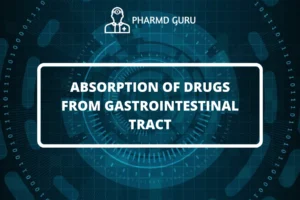One compartment open model intravenous injection is a topic in Biopharmaceutics & Pharmacokinetics, which covers: Introduction to one compartment open model, characteristics of one compartment open model, Classification of one compartment open model, Derivation of one compartment open model IV. Bolus unchanged drug in blood along with its Pharmacokinetic properties, Derivation of one compartment open model IV. Bolus unchanged drug in urine, which has two methods: 1) Urinary excretion method & 2) Sigma minus method, along with its Pharmacokinetic properties.
SCROLL DOWN TO THE BOTTOM OF THE PAGE FOR ACTUAL NOTES
The one compartment open model is a mathematical model commonly used in pharmacokinetics to describe the concentration-time profile of drugs administered intravenously. This model assumes that the drug is rapidly and uniformly distributed throughout a single well-mixed compartment within the body. Understanding the one-compartment open model helps in predicting drug behavior, determining dosing regimens, and optimizing therapeutic outcomes. In this article, we will explore the key concepts and equations associated with the one-compartment open model for intravenous injection.
The One Compartment Open Model
The one compartment open model simplifies the complex processes of drug distribution and elimination by assuming that the drug is instantaneously distributed throughout the body and that elimination occurs directly from this single compartment. It assumes that the drug follows first-order elimination kinetics, where the rate of elimination is proportional to the drug concentration.
Mathematical Representation
The concentration-time relationship in the one-compartment open model can be described using the following equation:
C(t) = C0 * e^(-kt)
Where:
- C(t) represents the drug concentration in the compartment at time t.
- C0 is the initial drug concentration after intravenous injection.
- k is the elimination rate constant, which reflects the rate of drug elimination from the compartment.
- e is the base of the natural logarithm.
Key Parameters
Several key parameters can be derived from the one-compartment open model:
- Elimination Half-Life (t1/2): The elimination half-life is the time required for the drug concentration in the compartment to decrease by half. It can be calculated using the equation t1/2 = 0.693 / k.
- Volume of Distribution (Vd): The volume of distribution is a theoretical parameter that represents the apparent volume into which the drug distributes. It is calculated as Vd = D0 / C0, where D0 is the initial drug dose.
- Clearance (CL): Clearance is the rate at which a drug is eliminated from the body and is defined as CL = k * Vd.
Applications and Clinical Implications
The one compartment open model has practical applications in pharmacokinetics and clinical practice:
- Dosing Regimen: The model helps in determining the appropriate drug dosage and dosing intervals to achieve the desired therapeutic concentration.
- Therapeutic Drug Monitoring: By understanding the concentration-time profile predicted by the one-compartment open model, healthcare professionals can monitor drug levels and adjust dosing regimens to maintain therapeutic concentrations within the desired range.
- Drug Interactions: The model aids in predicting drug-drug interactions by considering the impact of co-administered drugs on the elimination rate constant (k) and volume of distribution (Vd).
Conclusion
The one compartment open model for intravenous injection is a valuable tool in pharmacokinetics for understanding drug distribution and elimination. It simplifies the complex processes into a single compartment and assumes first-order elimination kinetics. By utilizing this model, healthcare professionals can optimize dosing regimens, monitor drug levels, and predict drug behavior in clinical settings. Understanding the one-compartment open model enhances our knowledge of pharmacokinetics and contributes to safe and effective medication use.
ACTUAL NOTES




